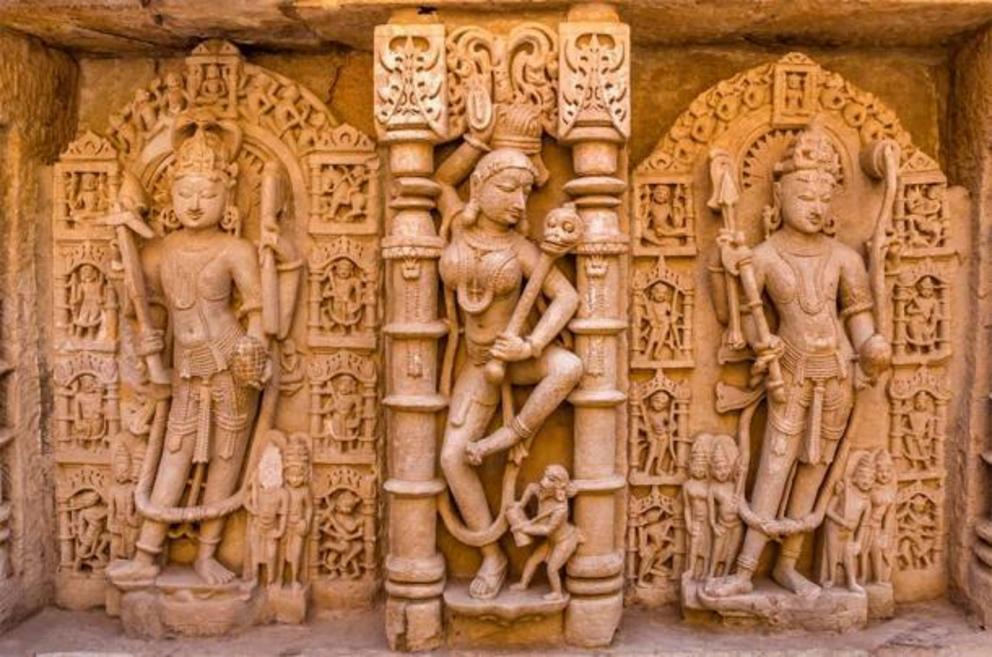Rani Ki Vav, the inverted temple that lay buried for centuries
Inner view of Rani ki vav, stepwell on the banks of Saraswati River. Memorial to an 11th century AD king Bhimdev I, Patan, Gujarat, India.
One of the most distinctive examples of Indian architecture is Rani ki vav, a remarkable stepwell. Astounding subterranean structures were designed to store and supply water to arid parts of India. The beautiful Rani ki vav, which translates to ‘Queen’s Stepwell’, is nearly a thousand years old. It is not only a stepwell, but also a Hindu temple that contains many stunning artworks.
The Ancient Roya; History of Rani ki vav
The remarkable structure was built on the bank of the Saraswati River in the 11 th century AD. At the time, Gujarat was ruled by the Chalukyas dynasty, who ruled much of Western India from the 9 th to the 12 th century AD. According to a Jain chronicle, it was built by a queen which is how the stepwell got the name. Queen Udayamati built the stepwell in memory of her husband Bhima I (1020-1064) but it was possibly completed by another Chalukya king.
The stepwell was constructed to provide for the local population, enabling them to go deep into the earth where a massive tank stored precious water . It is believed that once a bullock was used to raise buckets of water to the steps, where local people would retrieve them and take them home.
The stepwell was a major project and provided water to thousands. It was not only an ambitious hydrological project , but also a religious structure. Although the stepwell was built around the same time as the nearby Vimala Vasahi temple, Rani ki vav was intended to celebrate the sanctity of water.
 Intricately carved inner wall of Rani ki vav, Gujarat, India
Intricately carved inner wall of Rani ki vav, Gujarat, India
Over time the stepwell was flooded by the Saraswati River and became clogged up with silt and mud. During the British Raj in the 1940s, amateur antiquarians found the stepwell to be completely buried and only a few pillars were visible above ground. The efforts that were made to restore the site were completed in 1986. In 2014 it was granted the status of a UNESCO World Heritage site.
The Amazing Rani Ki Vav – Finest Example of Nanda-style Stepwell
The stepwell is classified as a Nanda-style stepwell, built in the Maru-Gurjara architecture style. The style originated in Northern India in the medieval age and Rani ki vav is considered to be one of the finest examples ever constructed.
This subterranean structure is 213 feet (65m) wide and 66 feet (20m) long. It is almost 100 feet deep (28m). A gateway to the stepwell is accessed by a flight of stairs. The seven levels of stairs leading to a deep circular well that was once flooded but is now dry. There are stepped corridors at every level with pavilions. More than 200 pillars grace the structure and the walls as well as the pillars are adorned with carvings and inscriptions . Because water is so scarce in the area, it is treated with reverence and respect, and the structure is therefore a sacred site.
The Sculptures of Rani ki vav,
With over 1500 sculptures of a religious, mythological and secular nature in various sizes, the site is highly decorated. These stylized images are excellent examples of classical sculpture. They are designed to replicate the universe, both the human realm as well as the spiritual realm . Gods from the Hindu Pantheon, such as Brahma, Vishnu, Shiva, and Ganesh watch over the space and figures of the nine planets of Hindu cosmology hold influence over human destiny.
 Sculptures of god and goddesses at Rani ki vav in Patan, Gujarat
Sculptures of god and goddesses at Rani ki vav in Patan, Gujarat
Naga Kanya is represented here as Nagas are spirits who reside in the underworld, protecting and offering the teachings of the Mother Goddess . The many other sculptures of women, seen in a variety of poses, mostly display them in a domestic setting. Wish-giving trees, often depicted in Hindu mythology, have been used to embellish certain areas.
Visiting Rani ki vav in Gujurat
The monument is a UNESCO World Heritage site and is protected by the Indian government. This large attraction is situated on a highway outside the town of Patan, which is 70 miles (127km) from Ahmedabad. An admission fee is charged, and it is recommended that at least 2 hours be set aside to allow visitor to fully explore this beautiful site.

